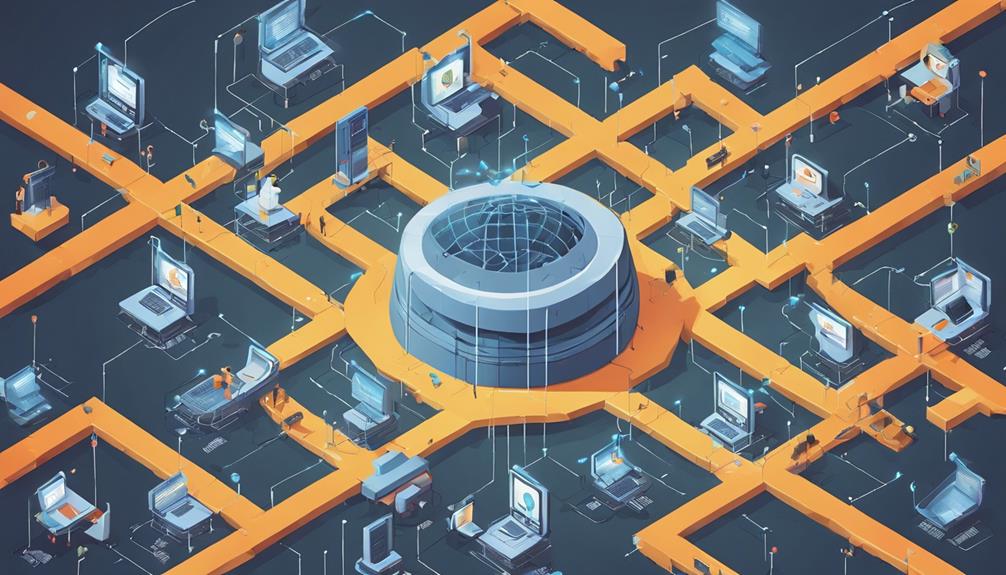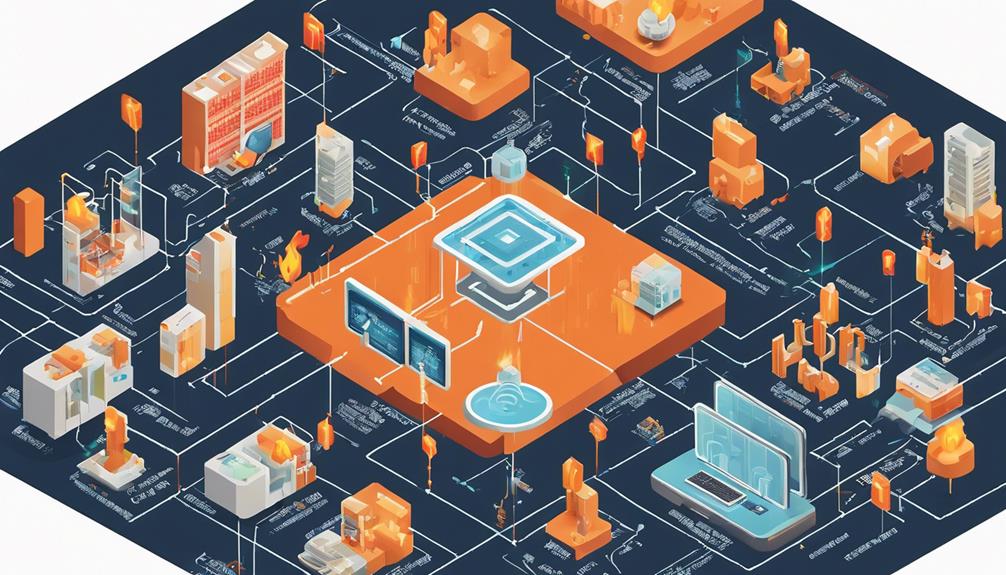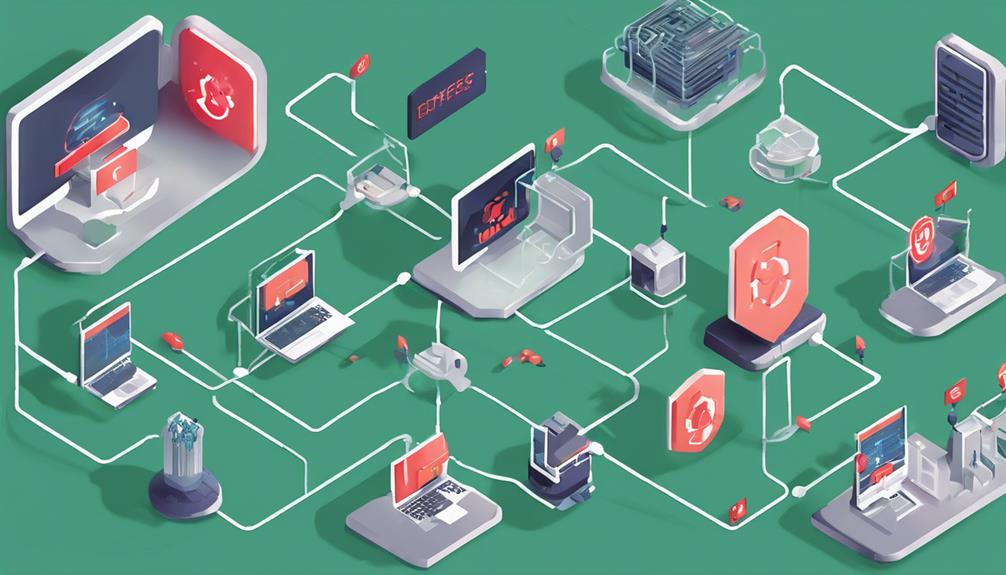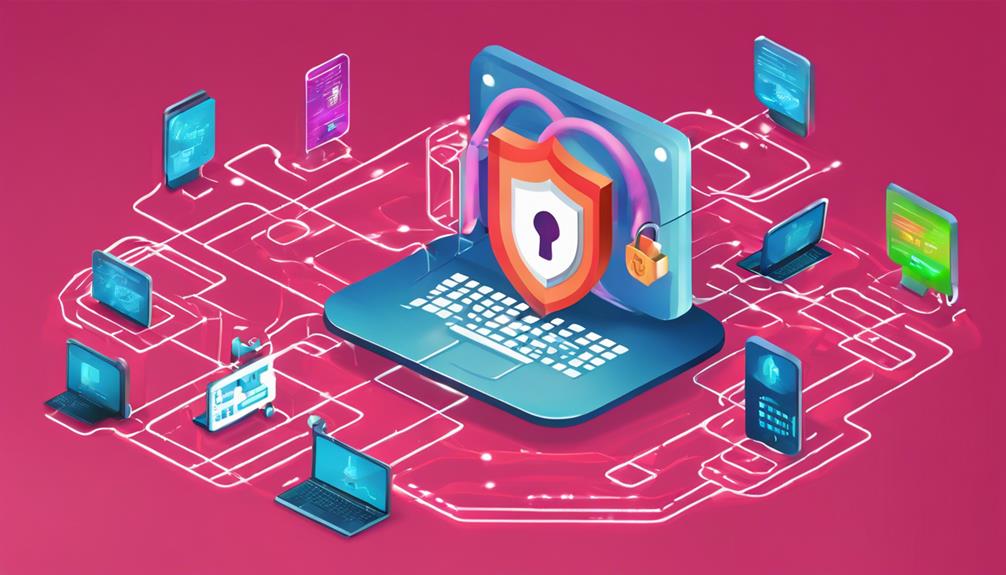Learn how to bolster your cybersecurity defenses through our guide on ethical hacking and perimeter defenses. Discover the importance of physical perimeter defenses with barriers and lighting, access control measures like mantraps, and network security protocols such as SSL and TLS. Explore security infrastructure components like fencing and barriers, and defense-in-depth strategies for thorough protection. Upgrade to TLS for enhanced encryption and data privacy. Strengthen your security against cyber threats effectively.
Key Takeaways
- Implement mantraps for effective access control.
- Strengthen security with robust perimeter walls.
- Use bollards to control and restrict access.
- Monitor security with PIDAS fencing.
- Enforce access control through trained security personnel.
Physical Perimeter Defenses
Physical perimeter defenses are essential elements of a thorough security strategy, including external boundary protection, structural barriers, and access control measures. These defenses play a critical role in safeguarding against unauthorized access to sensitive areas.
Perimeter walls, constructed from robust materials like concrete, bricks, barbed wire, and spikes, serve as the first line of defense, deterring potential intruders. Gates, equipped with strong hinges, locks, and motorized operation, regulate access effectively, ensuring only authorized individuals can enter.
Exterior lighting is another crucial component, discouraging trespassers and enhancing visibility during nighttime, thereby improving overall security measures.
Access Control Measures

Access control measures are essential components of a thorough security strategy, ensuring only authorized individuals have entry to sensitive areas. Security devices like mantraps play a critical role in preventing unauthorized access by allowing only one person at a time to enter, effectively enhancing the overall security posture.
The Defense in Depth Outside strategy complements access control measures by incorporating exterior sensors, alarms, and security guards to fortify the protection of sensitive areas.
Privacy measures within access control systems are paramount for safeguarding personal information and maintaining data confidentiality. Terms of Use serve as legal agreements that outline acceptable behavior and service limitations, further strengthening access control implementation.
Professionals with CISSP certification possess expertise in IT security, providing a globally recognized standard for implementing robust access control measures.
Network Security Protocols

Network security protocols are essential components in establishing secure data transmission and communication within an organization's IT infrastructure. These protocols, such as SSL and TLS, play an important role in ensuring data integrity and confidentiality during transmission. Compliance with regulations like GDPR is paramount to securely store and transmit data using these protocols, safeguarding against cyber threats and unauthorized access.
Security protocols form a key defense mechanism against external threats, working in tandem with tools like firewalls and intrusion detection systems. By adhering to best practices in implementing and maintaining network security protocols, organizations can greatly reduce the risk of breaches and data compromises. Ethical hacking practices often test the effectiveness of these protocols, helping organizations identify vulnerabilities and strengthen their overall security posture.
In today's digital landscape, where cyber threats are constantly evolving, robust network security protocols are fundamental for organizations to protect sensitive information and maintain the trust of their stakeholders.
Security Infrastructure Components

Foundation stability is a critical factor in establishing robust security infrastructure components to safeguard against potential threats.
In perimeter defenses, PIDAS fencing plays a significant role in detecting movement and enhancing security monitoring. It is essential to guarantee proper foundations for stable perimeter walls to maintain security integrity effectively.
Access points are protected using fixed or retractable bollards, which help control entry effectively. Security personnel often accompany gates to enforce strict access control measures, adding an extra layer of security against unauthorized entry.
Additionally, concrete barriers are utilized to provide permanent protection against potential vehicle threats, enhancing the overall security infrastructure. These components are vital in mitigating security risks and fortifying the perimeter defenses against various threats, including those posed by ethical hacking attempts.
Defense in Depth Strategies

When considering robust cybersecurity approaches, implementing Defense in Depth strategies is paramount for organizations aiming to fortify their security posture against diverse threat landscapes. This strategy involves the implementation of multiple layers of security defenses to protect against various vulnerabilities and attack vectors.
Here are three key aspects of Defense in Depth:
- Redundancy: By creating redundancy in security measures, organizations guarantee that if one layer fails, others can still provide protection, reducing the risk of a successful breach through a single point of failure.
- Holistic Approach: Defense in Depth combines physical, technical, and procedural security controls to mitigate risks effectively. This holistic approach addresses both internal and external threats, making it a versatile strategy for enhancing cybersecurity.
- Enhanced Security Posture: Implementing Defense in Depth helps organizations strengthen their overall security posture. By incorporating this strategy, organizations can better defend against sophisticated cyber threats, ultimately enhancing their resilience to potential attacks.
Utilization of SSL and TLS Protocols

SSL (Secure Sockets Layer) and TLS (Transport Layer Security) protocols are essential tools in securing online communication. SSL encrypts data to protect its confidentiality, while TLS enhances security features for improved protection.
Understanding the differences between SSL and TLS is vital for implementing the most suitable protocol for safeguarding sensitive information online.
Secure Data Transmission
Utilizing SSL and TLS protocols for secure data transmission is essential in safeguarding sensitive information exchanged over the internet. These protocols play a significant role in ensuring the integrity, authentication, and confidentiality of data during online transactions and other sensitive exchanges.
Here are three key aspects highlighting the importance of secure data transmission through SSL/TLS protocols:
- Encryption: SSL and TLS protocols encrypt data as it travels between servers and browsers, making it unreadable to unauthorized parties. This encryption is necessary for protecting sensitive information like login credentials and financial details during online transactions.
- Data Integrity: SSL/TLS protocols verify that data remains unchanged during transmission, preventing unauthorized alterations or tampering that could compromise the information being exchanged.
- Authentication: Websites use SSL/TLS certificates to authenticate their identity and establish secure connections with users. This authentication process helps users trust that they are interacting with legitimate websites, enhancing security during data transmission.
Encryption for Protection
The implementation of secure data transmission through SSL and TLS protocols is essential in safeguarding sensitive information exchanged over the internet.
SSL (Secure Sockets Layer) and TLS (Transport Layer Security) are encryption protocols that guarantee the confidentiality and integrity of data during communication.
Websites utilize SSL/TLS certificates to establish secure connections, protecting essential information like passwords and credit card details from malicious actors.
By encrypting data, SSL/TLS protocols prevent unauthorized eavesdropping and tampering, enhancing cybersecurity defenses against potential breaches.
The robust encryption provided by SSL and TLS is critical for securing online transactions, sensitive communications, and data transfers, making them fundamental tools in the arsenal of ethical hacking practices.
Whether safeguarding personal information or securing business transactions, the utilization of SSL and TLS encryption protocols is essential in fortifying the defenses of digital assets against cyber threats.
SSL Vs. TLS
Comparing the cryptographic protocols SSL and TLS illuminates the evolution and advancements in securing online communications. TLS, being the newer and more secure version, has replaced SSL due to its enhanced encryption capabilities and improved security features.
Here are key points differentiating SSL and TLS:
- Security Strength: TLS offers stronger security features compared to SSL, making it more resilient to cyber threats and attacks.
- Protocol Versions: SSL 3.0 and TLS 1.0 were the initial versions, with subsequent versions of TLS continually improving security measures.
- Industry Adoption: Organizations are increasingly shifting from SSL to TLS to benefit from enhanced encryption and protection against vulnerabilities.
Ethical hackers taking a course on cybersecurity would find understanding the differences between SSL and TLS essential for identifying and addressing potential security risks within network communications. Upgrading to TLS is recommended to strengthen defenses and safeguard data privacy and integrity in an evolving digital landscape.
Frequently Asked Questions
What Is the Goal of an Ethical Hacker Is Always to Improve Security?
The fundamental objective of an ethical hacker is to continually enhance security measures by proactively identifying vulnerabilities within systems. By focusing on strengthening defenses, ethical hackers play a pivotal role in fortifying security postures against potential cyber threats.
What Are Ethical Hackers Who Hack a System for Improving Its Security Features Called?
Ethical hackers who hack a system to enhance its security features are known as White Hat Hackers. These cybersecurity professionals focus on identifying vulnerabilities and strengthening defenses to protect systems from malicious attacks while operating within legal and ethical boundaries.
Why Is Ethical Hacking Important for Effective Security Management?
Ethical hacking is essential for effective security management as it proactively identifies vulnerabilities, reducing the time to detect breaches by 43% on average. This practice enhances security posture, compliance, and incident response capabilities.
What Are the Benefits of Ethical Hacking in Cyber Security?
Ethical hacking enhances cybersecurity by identifying vulnerabilities, preventing unauthorized access, and strengthening defenses. Benefits include proactively identifying weaknesses, reducing risks of breaches and financial losses, and ensuring robust security measures to protect data and assets.
Conclusion
In summary, fortifying your security through ethical hacking and perimeter defenses is vital in today's digital landscape.
By implementing physical perimeter defenses, access control measures, network security protocols, security infrastructure components, and utilizing defense in depth strategies, you can greatly reduce the risk of cyber threats.
Remember, a strong defense is the best offense in the world of cybersecurity.









